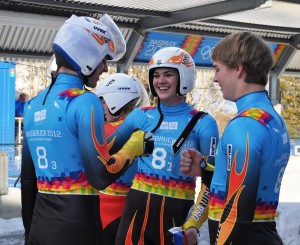By Emily Ridlington, Young Reporter at the Youth Winter Olympics, Innsbruck, Austria
The fastest time Saskia Langer from Germany has clocked on a luge track is a 125 kilometres per hour.
The 16-year-old said she is never afraid zipping down the track even with the death of Georgian luger Nodar Kumaritashvili days before the opening ceremonies at the 2010 Vancouver Olympics.
“It was a really bad day and we have those thoughts in our head and it was not easy but I think we know there is risk to what we do but we do it with that risk,” she said.
Similar thoughts are shared by members of the American luge team who took gold in the Mixed Team Relay, all of whom are 17-years-old.
Summer Britcher recalls one crash in Russia. “I crashed pretty bad, I hit the top of the curve twice and came down limp on my sled, I got back up and finished the race,” she said.
When watching these athletes I wonder why they would be part of such a sport that most people would never go near. I think as journalists we are often quick to judge folks who participate in unique activities. Especially with the birth of social media one sentence you tweet or one status update on Facebook can sometimes not encapsulate all the information. Often you have to go straight to the source.
American Pat Edmunds summarizes his sport quite well: “It’s a cool and crazy conflict.”
He said there’s a clash between the adrenaline rush and being relaxed and trying to remain composed. How you remain calm sliding down a track at high speeds I don’t know but Edmunds’ teammate Ty Andersen said if you tense up you will crash. Even at his young age he’s already been competing for six years.
Introducing children to the sport when they are young is key to teaching them the best techniques in order to be sure they stay safe.
Ensuring athletes have the best training and techniques are people like Fred Zimny. He coaches the American team and is a member of the International Luge Federation. They’re the governing body for the sport all around the world.
Zimny said many children would only dream of competing in such a sport.
“Kids when they’re 10-years-old, lay on a skateboard and ride down a hill — this is just taking them to the next step,” he said.
Even Austria’s Olympic luger Markus Prochk acknowledges there are dangers in his sport.
“The problem with the athlete from Georgia was he fell out of the track and it was a very sad for our luge family, said the Innsbruck native.
Since Vancouver, he said the track there has a lower star so athletes do not go so fast out of the start gate. Prock is a national sporting hero here in Austria having participated in six Olympic Games and he has six Olympic medals. His 16-year-old daughter Nina is now making a name for herself in the same sport.
You cannot deny the fact the athletes do get anxious especially after the death of Kumaritashvili but they have the courage to carrying in pursuit of the ultimate Olympic dream, wearing a Gold Medal around their neck and hearing their national anthem. This can be compared to having journalists go directly to the source even though you think you’ve got the whole story from just observing.






